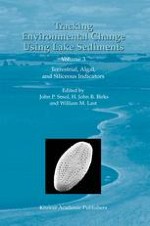2001 | OriginalPaper | Buchkapitel
Phytoliths
verfasst von : Dolores R. Piperno
Erschienen in: Tracking Environmental Change Using Lake Sediments
Verlag: Springer Netherlands
Enthalten in: Professional Book Archive
Aktivieren Sie unsere intelligente Suche, um passende Fachinhalte oder Patente zu finden.
Wählen Sie Textabschnitte aus um mit Künstlicher Intelligenz passenden Patente zu finden. powered by
Markieren Sie Textabschnitte, um KI-gestützt weitere passende Inhalte zu finden. powered by
Phytolith analysis of lake records is an important and currently underutilized tool of paleoenvironmental reconstruction. If investigators choose to undertake the time-consuming task of constructing modern phytolith reference collections for their study regions, their efforts are likely to be rewarded because phytoliths can be useful in the identification of specific taxa. Identifications of some key indicator families and genera should be possible utilizing existing published keys and photographs.The potential advantages of carrying out phytolith and pollen studies of a single lake record as part of a multi-proxy analysis seem to be considerable. For example, where pollen analysis is weak, as in the recognition of herbaceous and arboreal taxa of mature tropical rain forest, phytolith analysis provides significant information (Piperno, 1993). Conversely, in the recognition of woody, secondary tropical forest growth where phytolith analysis may be “silent”, pollen data come to the rescue. Phytolith studies have also significantly increased the number of taxa represented in lake profiles from the American tropical forest (e.g., Piperno, 1993), an important improvement in our attempts to decipher the history of species-rich tropical formations. Phytoliths and pollen grains are complementary avenues of paleoenvironmental reconstruction and they should be studied in tandem whenever possible.
